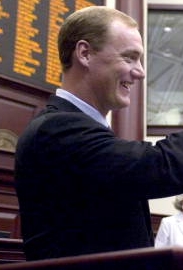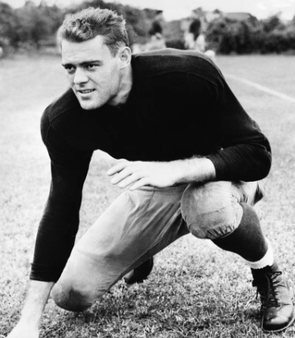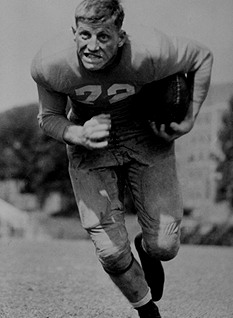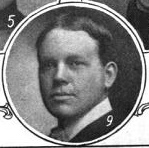Related Research Articles

The Heisman Memorial Trophy is awarded annually since 1935 to the most outstanding player in college football. It is considered the most prestigious award in college football and is presented by the Heisman Trophy Trust in early December. The most recent winner is former LSU Tigers quarterback Jayden Daniels.
John Gregory Huarte is an American former football quarterback who played with several teams in the American Football League (AFL), the National Football League (NFL), and in the World Football League (WFL) between 1965 and 1975. He played college football for the Notre Dame Fighting Irish, where he won the 1964 Heisman Trophy. He was inducted into the College Football Hall of Fame in 2005.

Leon Joseph Hart was an American football end and fullback who played for eight seasons, from 1950 to 1957, with the Detroit Lions of the National Football League (NFL). He won the Heisman Trophy and the Maxwell Award playing college football for the Notre Dame Fighting Irish in 1949.

Christopher Jon Weinke is an American football coach and former football and baseball player. After spending six years in the Toronto Blue Jays minor league baseball system, he enrolled at Florida State University at the age of 25, and played college football as a quarterback for the Florida State Seminoles. He thereafter played in the National Football League (NFL), where he spent most of his career with the Carolina Panthers.

John William Heisman was a player and coach of American football, baseball, and basketball, as well as a sportswriter and actor. He served as the head football coach at Oberlin College, Buchtel College, Auburn University, Clemson University, Georgia Tech, the University of Pennsylvania, Washington & Jefferson College, and Rice University, compiling a career college football record of 186–70–18.

Paul Robert Giel was an American college football and professional baseball player from Winona, Minnesota. He was an All-American in both sports at the University of Minnesota.

Howard Albert "Hopalong" Cassady was an American football halfback and split end who played in the National Football League (NFL). He played college football for the Ohio State Buckeyes, where he won the Heisman Trophy in 1955. Cassady played in the NFL for eight seasons, seven of them for the Detroit Lions, with whom he won the 1957 NFL Championship Game. He was inducted into the College Football Hall of Fame in 1979.

Lawrence Morgan Kelley was an American football end who played for the Yale Bulldogs football program from 1934 to 1936. He was the captain of the 1936 Yale Bulldogs football team that compiled a 7–1 record and was ranked No. 12 in the final AP Poll. He was selected as a unanimous first-team All-American and won the Heisman Trophy as the best player in college football.

The 1916 Cumberland vs. Georgia Tech football game was played on October 7, 1916, between the Cumberland College Bulldogs and the Georgia Tech Engineers on the Engineers' home field of Grant Field in Atlanta. Georgia Tech defeated the Bulldogs 222–0 for the most lopsided score in the history of college football.

William Beattie "Big Chief" Feathers was an American football player and coach of football and baseball. He played college football and college basketball at the University of Tennessee and had a seven-year career in the National Football League (NFL) playing for the Chicago Bears and two other teams.

Joseph Napoleon "Big Chief" Guyon was an American Indian from the Ojibwa tribe (Chippewa) who was an American football and baseball player and coach. He played college football at the Carlisle Indian Industrial School from 1912 to 1913 and Georgia Tech from 1917 to 1918 and with a number of professional clubs from 1919 to 1927. He was inducted into the Pro Football Hall of Fame in 1966 and the College Football Hall of Fame in 1971.

Michael Joseph "Iron Mike" Donahue was an American football player, coach of football, basketball, baseball, tennis, track, soccer, and golf, and a college athletics administrator. He served as the head football coach at Auburn University, at Louisiana State University (1923–1927), and at Spring Hill College (1934).

The Chicago Maroons are the intercollegiate sports teams of the University of Chicago. They are named after the color maroon. Team colors are maroon and gray, and Phil the Phoenix is their mascot. They now compete in the NCAA Division III, mostly as members of the University Athletic Association. The University of Chicago helped found the Big Ten Conference in 1895; although it dropped football in 1939, its other teams remained members until 1946. Football returned as a club sport in 1963, as a varsity sport in 1969, and began competing independently in Division III in 1973. The school was part of the Midwest Collegiate Athletic Conference from 1976 to 1987, and its football team joined the Midwest Collegiate Athletic Conference's successor, the Midwest Conference (MWC), in 2017. In the 2018–19 school year, Chicago added baseball to its MWC membership, and elevated its club team in women's lacrosse to full varsity status, with that sport competing in the College Conference of Illinois and Wisconsin (CCIW).

George Cafego was an American football player and coach of football and baseball. He played college football at the University of Tennessee, earning varsity letters 1937–1939, and professionally in the National Football League (NFL) with the Brooklyn Dodgers, Washington Redskins, and Boston Yanks. He served as the head baseball coach at the University of Wyoming in 1950 and at his alma mater, Tennessee, from 1958 to 1962. Cafego was inducted into the College Football Hall of Fame as a player in 1969.

The Brown Bears are the sports teams that represent Brown University, an American university located in Providence, Rhode Island. The Bears are part of the Ivy League conference. Brown's mascot is Bruno. Both the men's and women's teams share the name, competing in 34 National Collegiate Athletic Association (NCAA) Division I sports. In football, the Bears, along with all other the Ivy League teams, compete in the Football Championship Subdivision (FCS).

Arthur Vincent "Demon" Campbell was an American Major League Baseball outfielder. He played all or part of six seasons in the major leagues between 1908 and 1915. He played for the Boston Braves, Chicago Cubs, Pittsburgh Pirates, Indianapolis Hoosiers, and Newark Peppers.

Marvin Orestus Bridges was an American football, basketball, and baseball player and football coach. He served in the Spanish-American War, and is buried at Arlington National Cemetery.

Thomas Louis Spence was an American college football player. Spence also played on the baseball, basketball, and track teams.

James Corbett Senter was an American college football player.

John Greene "Tiny" Henderson was a college football and baseball player and coach. He was from Ocilla, Georgia.
References
- ↑ "Heisman Picks All-Star Team From SIAA Ranks - Material Is Poor". Tampa Tribune. May 26, 1914. p. 7. Retrieved November 10, 2017– via Newspapers.com.
